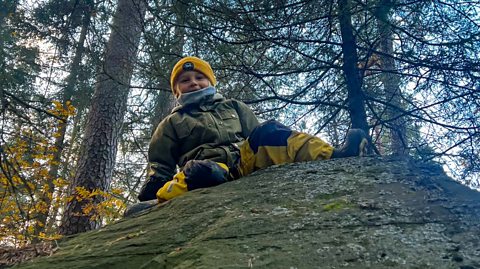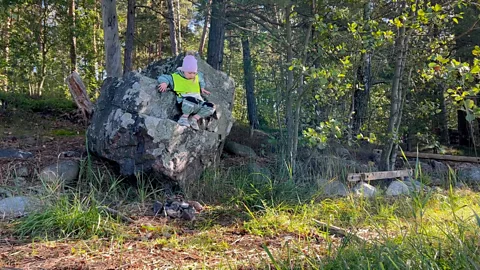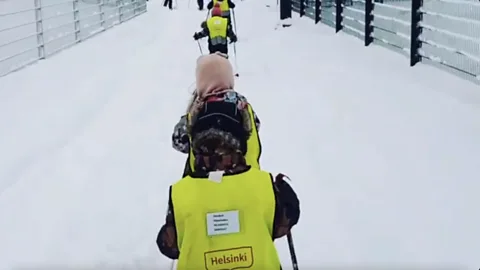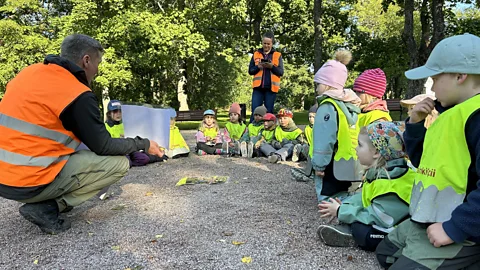How forest schools boost children’s immune systems
 Juho Pietarila
Juho PietarilaAt a Helsinki nursery, children spend all day in the forest. Erika Benke explores how outdoor learning benefits children's health and teaches them to value nature.
"Mornings are now easy. When I say 'it's time to leave the house', he picks up his bag and says 'OK, let's go'." says Juho Pietarila, whose four-year-old son Kauko recently started attending the forest group in Hopealaakso nursery in the Finnish capital Helsinki.
It's a big change, he says. Kauko regularly threw tantrums before he switched groups.
Kauko is now in the nursery's Samoojat group. 'Samoojat' is an old-fashioned Finnish word for people who forage in the forest.
Kauko hardly spends any time inside at nursery. He is out in the forest all day.
"These children are outdoors all the time, exploring nature, even in the winter," says Pietarila. "It doesn't matter if it's raining or snowing. My son says it's always good weather for the Samoojat."
It's quite a statement from a four-year-old who lives in a city with an average winter daytime temperature is -2C (28F) and permanent snow on the ground for at least two months.
Throughout the year, on Monday, Tuesday and Wednesday mornings, the Samoojat group of 21 children aged three to five trek for up to 40 minutes in the forest to get to their base camp. They spend seven hours outdoors, eating lunch in an open shelter and taking a nap in a tent before walking back to the nursery mid-afternoon.
Scandinavian-style forest schools and nurseries are spreading all around the world. Outdoor learning is increasing seen as an important way of connecting children with nature.
A wealth of studies have shown that spending time in natural spaces has many health and psychological benefits for children, such as reduced obesity, improved mental wellbeing, increased resilience and faster cognitive development. It can also encourage the development of environmentally conscious behaviour by fostering an appreciation and respect for the natural world.
A notable aspect of cognitive development among children who take part in outdoor learning is a sense of responsibility towards local spaces. "These children will understand much more easily why it's important to recycle and pick up trash," says Annina Kuusisto, a professor in early childhood education at the University of Helsinki. "It's a small thing but it's important as it helps build respect for the environment. They will be more likely to take action in the future to protect nature and fight climate change."
You might also like:
When the ground is frozen, from November to March, the Samoojat children eat lunch and take a nap in a nearby house. Even then they are outside for five to six hours, often in freezing cold weather.
Much of the day runs along a well-established routine, with well over half of the time dedicated to free play when the children roam free in the forest and along the seaside. They build bridges from branches, pick berries, climb trees and observe sea life. They are supervised by three teachers in orange high-vis jackets who they know they always have to keep within sight.
Sign up to Future Earth
Sign up to the Future Earth newsletter to get essential climate news and hopeful developments in your inbox every Tuesday from Carl Nasman. This email is currently available to non-UK readers. In the UK? Sign up for newsletters here.
On Thursdays, the children go on a trip somewhere in the Helsinki area. Fridays are nest days: the only day when the group is based in the nursery.
"Even then they're out in the yard most of the time. We only really need a nest day so I can get on with all the admin," laughs Samuli Rabinowitsch, the nursery teacher leading the group.
Forests contain a higher diversity of species and microbes in their soil than other environments. Coming into contact with friendly bacteria has been shown to be beneficial not only to children roaming in the forest all day but also to those attending nurseries in cities. (Read more about how mud boost children's immune system).
A Finnish study found that playing in grass and forest undergrowth, such as heather and blueberry planted in nursery yards at four daycare centres, boosted the immune systems of three to five-year-old children within 28 days.
Researchers found that the microbial diversity had increased on the skin and in the guts of children who regularly played outside among such greenery, indicating a healthier immune system. They also had a greater number of T cells, which play an important role in our immune response, and the proportion of anti-inflammatory molecules in the blood plasma had also increased.
According to Aki Sinkkonen, a research scientist with the Natural Resources Institute Finland, who led the study, the results support the assumption that contact with nature prevents disorders in the immune system, such as autoimmune diseases and allergies.
The scientists' findings fit with Rabinowitsch's own experience. "Children in my group get dirt in their mouths all the time and they're more resilient to infections. They rarely catch a cold," he says.
 Erika Benke
Erika BenkeThe five-year-olds in the forest group take turns to lead the group each day. They decide which paths to take on the way to and from the base camp. On the day I visited, Ronja confidently led the group through rocky terrain. After arrival, she counted the children and having confirmed that nobody was missing, she ran a song and rhyme session.
She also asked the others a few simple questions about the time of the year, sunrise and sunset and the weather. The children listened, eagerly put up their hands and waited until Ronja chose one of them to answer.
It was a brilliant demonstration of some of the key psychological benefits of outdoor learning described by researchers: improvements in behaviour, social skills, self-control, increased resilience and assertiveness.
"These kids can do everything. They solve problems together. They help each other. They will get up after a fall and they push themselves even when they're tired," says Rabinowitsch.
What are the Samoojat children like?
The Samoojat children appeared to be remarkably mature, independent and well-behaved.
They took off their shoes and a layer of clothes on their own before going to the tent for a nap. They helped themselves to lunch, skilfully manoeuvring large serving forks and spoons to grab fish fingers and boiled potatoes and picked their favourite salad ingredients, leaving very little mess around the food station.
They had no problem organising their 4-6kg (8.8-17.6lb) backpacks before heading back from the forest at the end of the day and none of them complained about carrying them.
The children were able to put up and take down the tent with very few instructions.
Rabinowitsch says outdoor education in winter brings the same benefits as in summer. He shrugs off suggestions that the children get cold. "There's no such thing as bad weather, only bad clothing," he says, blurting out Finns' standard reply to foreigners questioning the sanity of staying outside in freezing weather.
Hopealaakso nursery says all the children play outdoors for at least two hours a day, the standard amount of time in Finnish daycare facilities, no matter the weather. They are well-equipped with layers of thermal clothing, warm jackets, waterproof coats and snowsuits to cope with the elements.
"It's standard gear in this climate. We don't buy these clothes just because our son goes to this nursery: everybody here has them anyway," says Pietarila, Kauko's father.
But the Samoojat group needs to stay warm for up to six hours in the Helsinki winter, at times with strong winds blowing in wet snow, in sub-zero temperatures. The children need more than warm clothes to feel comfortable. Rabinowitsch says the key is to keep moving.
"We have snowball fights, we ski, ice-skate and sledge. We teach the children that they can't stay put. And of course we check their gear all the time," he says.
Ensuring that children have appropriate protection is crucial as they are more susceptible to cold than adults.
Children's skin in proportion to their weight is larger than that of adults, which significantly affects thermoregulation.
"Children also have less subcutaneous fat tissue, which acts as an insulator, and a lower amount of muscle mass, which means that children are less effective than adults at producing body heat through shivering," says Tiina Ikäheimo, professor at the department of community medicine at the Arctic University of Norway in Tromso.
 Erika Benke
Erika BenkeSo, how is it possible that children don't freeze? They need to be adequately dressed and supervised at all times, says Ikäheimo. "If there's numbness, pain or pale spots on the skin, these are signs that a child is at increased risk of cold injury. They need to be taken indoors at that point," she says.
Ikäheimo says children are often so immersed in play that they don’t notice that they’re getting seriously cold. "Children don't monitor their feet. It's the carers' job."
Protecting the extremities such as hands and feet are especially important for children, Ikäheimo adds. "Wet clothes and boots must be changed immediately. Sufficient nutrition and drinking hot fluids is also important: they all help protect from the cold."
Children have one advantage over adults when it comes to coping with the cold: they are generally more active.
"Exercising is a great way to produce body heat that prevents children from cooling down even in lower temperatures than Helsinki's," Ikäheimo says.
"The beauty of a winter forest, with its reduced noise, is that it also has significant mental health benefits: it lifts spirits and makes it easier to develop strategies to cope with the cold, such as games and exercises in the snow. The key is to keep moving: exercise produces body heat," she says.
Understanding risks in a cold environment is essential, says Mike Tipton, professor of human and applied physiology at the University of Portsmouth in the UK.
"There are more cold injuries in places like Italy where people are not used to winter weather than in Finland. Children in Scandinavian countries learn how to behave in the cold at a very young age and if they wear the right clothes, they have no problem maintaining the temperatures to remain safe and well."
There hasn't been any scientific research into how children react to cold weather but we know that adults' bodies adapt well after repeated exposure. "If you go cold-water swimming or ice-swimming on a regular basis, your body will acclimatize," says Ikäheimo. "It becomes less stressed and you won't feel that cold."
Pushing our bodies to get used to the cold also helps us maintain our ability to regulate body temperature.
"As a species we've become what I call thermostatic: we control our temperature everywhere: in the car, at home, at work. Just like with any other system in our bodies, if you don't use it, you lose it," says Tipton.
Children's behaviour is another key to understanding how they can thrive in the cold.
Being part of a group like the Samoojat makes a big difference, says Tipton.
"These children don't just go into a cold environment: they're with friends, having fun on an adventure in a beautiful place. In other words they're being entertained and that makes them remarkably resilient to cold," he says.
 Erika Benke
Erika BenkeHow can children living in concrete jungles benefit from outdoor education?
Forest schools are rising in popularity around the globe. But they're not within easy reach for everyone: according to the World Bank, 56% of the world's population now lives in densely populated urban areas. Still, experts say children growing up in cities are not necessarily excluded from the benefits of outdoor education.
Biodiversity in a city is never going to be as rich as in the forest – but it's still important.
Looking after plants has developmental benefits, says Kuusisto. "Feeding pets and watering plants helps develop children's respect for the environment. Even very young children will understand that plants and animals need care to live and grow. This awareness builds their relationship with nature which is very important to them."
Kuusisto says she's come across some very young children with climate anxiety. "When they have a caring relationship with nature, they'll see that there are things they can do. Encouraging that active role is the best we can do to help them build resilience to ease these worries."
CARBON COUNT
The reporting for this story was conducted while the writer was on another assignment. The travel included a return flight, but as it was not the primary purpose of the trip, we have not counted the carbon emitted from the flight in our calculations. For the record, however, the carbon emissions from the return flight were 670kg. The digital emissions from this story are an estimated 1.2g to 3.6g CO2 per page view. Find out more about how we calculated this figure here.
Kuusisto conducted a study where she gave 45 children an iPad for a week and asked them to draw pictures, take photos and videos about the most meaningful part of their day.
"The natural environment came out on top. All the children mentioned it every day," says Kuusisto.
Carol Murdoch, a consultant who helps teachers in the UK deliver learning outdoors, says stepping out of school to visit a library or a supermarket can be just as beneficial as being in a forest. Even a concrete playground is a good place to teach children about nature, she says.
Murdoch recently ran a session for primary school children who had been learning about ocean animals in the tiny village of Strathaven near Glasgow in Scotland.
"They had an idea that a whale was huge but they only appreciated how vast it was after they measured out its length, drew it in chalk in the playground and saw how much space it took up," she says. "There's rarely a chance to explore large-scale measures in a meaningful way indoors, but there is a concrete playground."
Back at Hopealaakso nursery in Helsinki, Rabinowitsch gets a phone call from a local school nurse who noticed that some children's lung capacity, basic motor skills and overall fitness were much better than average. She asked parents which nursery the children had attended and the trail led to Rabinowitsch.
"She asked me what on earth I was doing with these children," says Rabinowitsch with a smile.
Rabinowitsch is beaming with pride as he describes the children's excellent physical condition and mental health. But the crowning glory is the Samojaat's rock-solid bond with nature. "Their eyes light up when we set off for our base camp in the morning. And when they go home in the afternoon, they don't want to go to the playground. They keep asking their parents to go to the forest instead. They are children of the forest."
--
If you liked this story, sign up for The Essential List newsletter – a handpicked selection of features, videos and can't-miss news delivered to your inbox every Friday.
